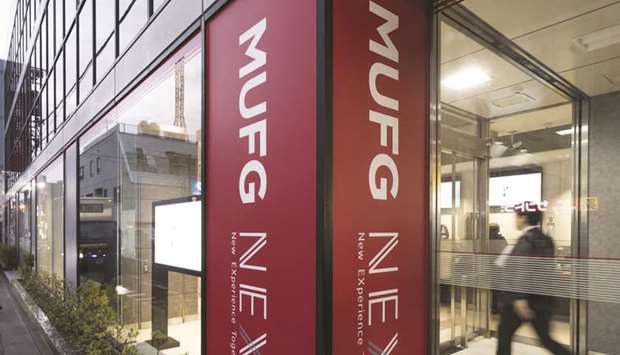Japan’s biggest banks are expected to project the highest bad-loan costs in a decade when they issue annual profit forecasts this week, joining global peers in bracing for the worst global recession since the Great Depression.
Credit costs are likely to be the biggest factor impacting the earnings outlook of Mitsubishi UFJ Financial Group Inc, Sumitomo Mitsui Financial Group Inc and Mizuho Financial Group Inc, given their relatively small dependence on volatile trading and fee businesses.
The coronavirus pandemic has prompted banks around the world to set aside billions in anticipation that companies and individuals will struggle to repay their debts.
For Japanese lenders, the prospect is significant because for years they have been relying on low soured loans to prop up earnings that have sagged under the weight of rock-bottom interest rates.
“There’s no doubt that the new year is the most challenging for megabanks since the global financial crisis a decade ago,” said Michael Makdad, an analyst at Morningstar Inc in Tokyo.
He sees this year’s bad-loan costs totalling about ¥800bn ($7.4bn). The three lenders are scheduled to report results for the year ended March 31 on Friday, along with their forecasts for the current fiscal year.
MUFG and Mizuho have already published preliminary earnings in recent weeks, shifting attention to their projections for the new year.
MUFG said last year’s net income sank to a decade low on writedowns of its holdings in Southeast Asian banks whose shares tumbled.
Mizuho said its annual profit rose less than it anticipated after setting aside extra reserves for the impact of the outbreak.
JPMorgan Chase & Co analyst Rie Nishihara estimates credit costs at MUFG will jump to around 30 basis points of its total loans outstanding this fiscal year, or about ¥300bn, the most since the aftermath of the 2008-2009 crisis.
She also expects a big increase at the other two banks. Still, credit costs will remain much smaller than those posted during the global financial crisis because a slew of government aid programmes will provide troubled borrowers with life support, according to Nishihara. “It’s not that the financial system is in trouble,” she said. “So, we expect a relatively quick economic recovery.”
Makdad said he doesn’t expect the lenders will resort to raising equity capital, unlike during the financial meltdown.
Analysts also predict the banks will avert large-scale writedowns on their shares held in Japanese corporate clients, because many local stocks are trading above levels that would trigger such charges, even after this year’s rout.
The Nikkei 225 Stock Average is around 20,000 now, more than double where it was in the year ended March 2009. “Given the level now, it’s hard to expect stock writedowns of a similar scale,” said Toyoki Sameshima, an analyst at SBI Securities Co.
Shares of the three banks themselves have been battered this year, falling at least 27%. That’s left them trading at about a third of the book value of their assets.
Bloomberg Intelligence sees little upside given the persistent monetary easing by central banks.
Multiples may continue to languish at less than half their book values, while revenue headwinds may persist due to Bank of Japan easing and the US Fed’s rate cuts, Bloomberg Intelligence said.
One bright sign is a pickup in domestic lending as companies tap credit to ride out the pandemic.
Loans by major banks jumped 3.4% last month from a year earlier, the most since 2009, Bank of Japan figures showed yesterday. Investors will also be looking for any guidance on shareholder payouts at this week’s briefings by bank executives.
Unlike its counterparts in markets including Switzerland and the UK, Japan’s Financial Services Agency has refrained from urging lenders to withhold dividends during the current crisis.
“The Japanese FSA has been somewhat unique among major banking jurisdictions in not providing any explicit guidance on restrictions to shareholder distributions,” Makdad said. “So I am really watching to see how Japanese bank management approaches the question of future dividends and share buybacks.”

A customer enters a MUFG Bank Next store in Tokyo. The Japanese lender said last year’s net income sank to a decade low on writedowns of its holdings in Southeast Asian banks whose shares tumbled.
